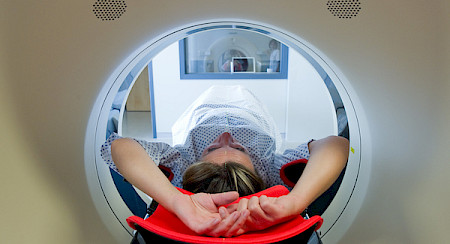Cardiovascular
Cardiac MRI and CT angiography of the coronaries, the supra-aortic arteries, the aorta and its branches, including those of the lower limbs; venous Doppler ultrasound. Cardiac scintigraphy.
Prevention and check-ups
Full-body (MRI), lung (CT), brain (MRI, scintigraphy, PET/CT), densitometry, mammography, ultrasound scans, digital radiography.
Digestive system, liver, gall bladder, pancreas, adrenal glands
Ultrasound, CT, MRI, study of swallowing, transits, enemas, study of the small intestine using enteroclysis, CT enterography, MR enterography, virtual colonoscopy using CT, standard defecography, MR defecography, gastric emptying and hepatobiliary scintigraphy, Octreoscan, PET/CT, biopsies, drainage of intra-abdominal collections. Insertion and care of percutaneous feeding tubes (PRG and PRJ), percutaneous intestinal stenting, drainage and stenting of bile ducts, removal of gallstones.
Neck ultrasound including thyroid and parathyroid glands; punctures; CT and MRI; thyroid and parathyroid scintigraphies; beta treatment of hyperthyroidism; Thyrogen tests to monitor thyroid cancers. Ablation of thyroid nodules using radiofrequency.
Treatment procedures
Drainage; spine and joint infiltrations, isotope treatment in the form of alpha therapy and beta therapy.
Abdominal and transvaginal ultrasound; pelvic and abdominal MRI; abdominal CT; bone densitometry with trabecular bone score.
Brain, spinal column, spinal cord and pituitary CT and MRI; CT angiography and magnetic resonance angiography of pre- and intracerebral vessels; infiltrations; cementoplasties. But also brain perfusion and specialised SPECT/CT, such as Datscan; 18FDG and fluorocholine PET/CT, and PET/CT with specific radiotracers for Alzheimer’s disease.
Standard radiography, ultrasound, CT scan, MRI. Performance of biopsies, cementoplasties, percutaneous thermal ablations (hepatic, renal, pulmonary, bone, etc.). Full-body and bone scintigraphies with specific radiotracers, and full-body PET/CT scans.
ENT
Study of swallowing; neck, facial bone and sinus CT scans; MRI of the neck and temporomandibular joints; CT dacryocystography; punctures; ultrasound; study of the salivary glands using ultrasound, CT and MRI; PET/CT; and scintigraphies. Minimally invasive treatment of head and neck pain.
Digital radiography of the musculoskeletal system; MRI; CT; MR and CT arthrography; ultrasound; infiltrations; biopsies; full-body and bone SPECT/CT.
Densitometry with trabecular bone score and vertebral morphometry, analysis of body composition, cementoplasties, vertebral augmentation.
Paediatrics
Abdominal ultrasound including kidneys, bladder, pylorus and soft tissues; cranial transfontanellar ultrasound in infants; scrotal and hip ultrasound. Transits, enemas, voiding cystourethrogram, CT scan, MRI (depending on the child’s age), digital radiography including bone age, and all kinds of paediatric scintigraphies.
Pulmonology
Digital radiography, pulmonary CT, biopsies, drainage. Bronchial embolisation and embolisation of pulmonary arteriovenous malformations. Pulmonary scintigraphy.
Senology
Mammography with tomosynthesis and double reading; screening mammography within the cantonal foundations’ framework; ultrasound; MRI; biopsies with ultrasound, stereotactic radiosurgery and MRI; lymphoscintigraphy.
Urology (kidneys, urinary tract and prostate)
Abdominal and endorectal ultrasound, CT and MRI, IVP (intravenous pyelogram), VCUG (voiding cystourethrogram), cystography, biopsy, and drainage. Insertion of percutaneous nephrostomies. Renal scintigraphy (MAG3 and DMSA), FDG and fluorocholine PET/CT, prostate MRI with navigation software for biopsies (Artemis).


























